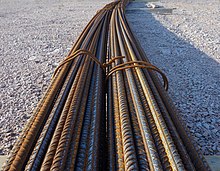
Rebar (short for reinforcing bar), known when massed as reinforcing steel or steel reinforcement,[1] is a tension device added to concrete to form reinforced concrete and reinforced masonry structures to strengthen and aid the concrete under tension. Concrete is strong under compression, but has low tensile strength. Rebar usually consists of steel bars which significantly increase the tensile strength of the structure. Rebar surfaces feature a continuous series of ribs, lugs or indentations to promote a better bond with the concrete and reduce the risk of slippage.
The most common type of rebar is carbon steel, typically consisting of hot-rolled round bars with deformation patterns embossed into its surface. Steel and concrete have similar coefficients of thermal expansion,[2] so a concrete structural member reinforced with steel will experience minimal differential stress as the temperature changes.
Other readily available types of rebar are manufactured of stainless steel, and composite bars made of glass fiber, carbon fiber, or basalt fiber. The carbon steel reinforcing bars may also be coated in zinc or an epoxy resin designed to resist the effects of corrosion, especially when used in saltwater environments. Bamboo has been shown to be a viable alternative to reinforcing steel in concrete construction.[3][4] These alternative types tend to be more expensive or may have lesser mechanical properties and are thus more often used in specialty construction where their physical characteristics fulfill a specific performance requirement that carbon steel does not provide.
- ^ Merritt, Frederic S., M. Kent Loftin and Jonathan T. Ricketts, Standard Handbook for Civil Engineers, Fourth Edition, McGraw-Hill Book Company, 1995, p. 8.17
- ^ "Coefficients of Linear Thermal Expansion". The Engineering ToolBox. Retrieved 6 July 2015.
- ^ "Bamboo Reinforced Concrete". The Constructor. 12 December 2016. Retrieved 29 October 2019.
- ^ Brink, Francis E.; Rush, Paul J. "Bamboo Reinforced Concrete US Naval Civil Engineering Laboratory". Roman Concrete Research. Retrieved 29 October 2019.